Currently viewing: People | Next: Communities
Our people are the central pillar of our labour-intensive mining business. Without them, Exxaro cannot thrive. As our sustainability and productivity are inextricably linked to their holistic wellbeing, we are dedicated to protecting their safety, health and wellbeing, personal development, and other needs and expectations of our people.
We uphold our licence to operate through our people and diversity and inclusion strategies, alignment with and commitment to internal policies, and our employee value proposition (EVP).
Our people and partners have the capabilities, mindset, environment and passion to achieve our purpose, and we as a company can build on each other's creativity and experience. We have several measures to ensure we empower our people to create impact.
The board, supported by the SERC, has ultimate accountability for our people's health, safety, engagement and development. The executive head: human resources, supported by various management departments, is responsible for developing and implementing employee-related strategies.
Our robust people strategy is the foundation of our employee engagement approach. The strategy is based on six pillars:
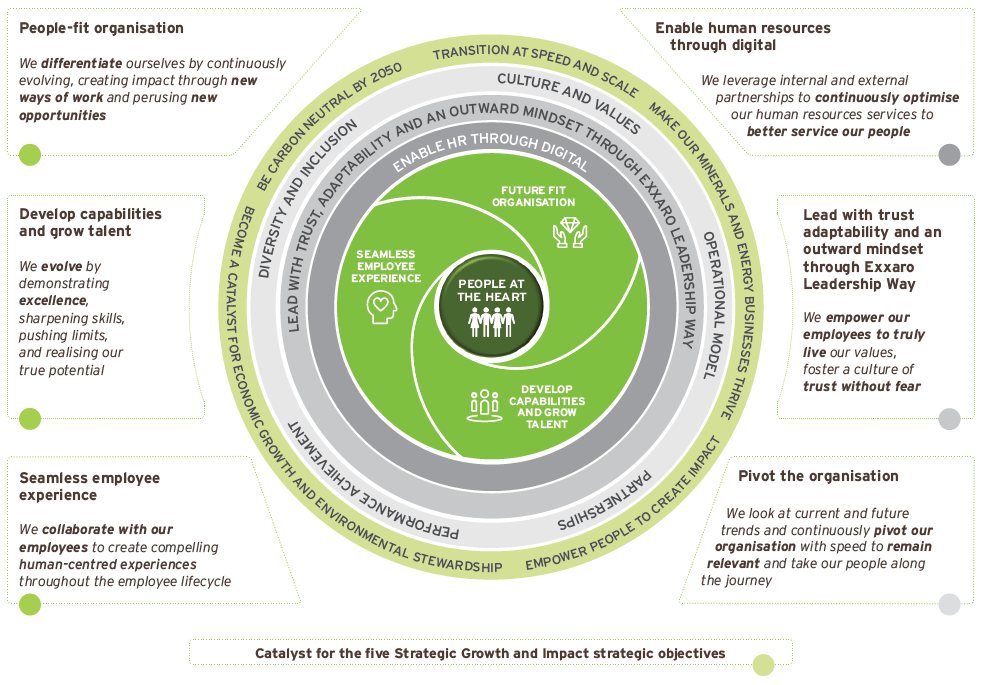
These pillars are underpinned by a commitment to a people-fit organisation, developing capabilities and to enable human resources through our purpose to power better lives in Africa and beyond.
The safety, health and wellbeing of our employees and host communities remain a priority. We strive to achieve zero harm through collective responsibility, commitment and risk awareness.
Our Sustainable Growth and Impact strategy is a strategic and tactical response to the dangerous effects of climate change. We aim to grow our organisation through investments in low-carbon minerals and renewable energy while creating positive impact for people and our natural environment, and supporting a just transition for people and communities.
By embedding our culture – the behaviour we expect from all employees – throughout the business, we are geared to deliver on our Sustainable Growth and Impact strategy as it evolves.
We are mindful that our journey has an impact on our people. To negate any negative impacts, we have a robust EVP, supported by our diversity and inclusion strategy through the co-creation of an innovative and agile work environment. Value-adding people solutions afford a fulfilling work experience with growth and development.
We also maintain sustainable human resource governance with a comprehensive suite of policies covering employment, diversity and inclusion, racial and sexual harassment, labour relations, occupational health and safety, training and education, among others.
Cennergi's two operations are SPVs without management or employees but a management service agreement with Cennergi. The majority of Cennergi's employees are hired by two contractors who have 10 and five full-time employees on site at Tsitsikamma community windfarm and Amakhala Emoyeni windfarm respectively. These contractors use various sub-contractors for specific maintenance activities. Other local contractors support various environmental programmes on the sites. Cennergi maintains human resources governance by applying a comprehensive suite of policies.
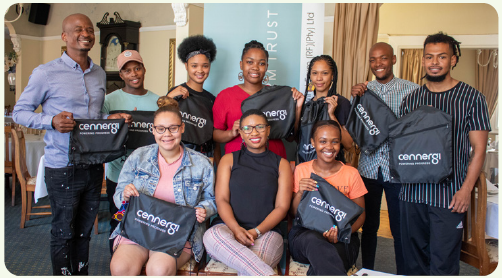
Exxaro employed 18 813 people (2020: 22 466) - 35.84% full-time employees and 64.13% contractors. The significant fluctuation in the number of employees over the past year is a reflection of the sale of ECC*.
* Divestment concluded in September 2021.
For detail on our human capital-related performance, refer to the sections that follow.
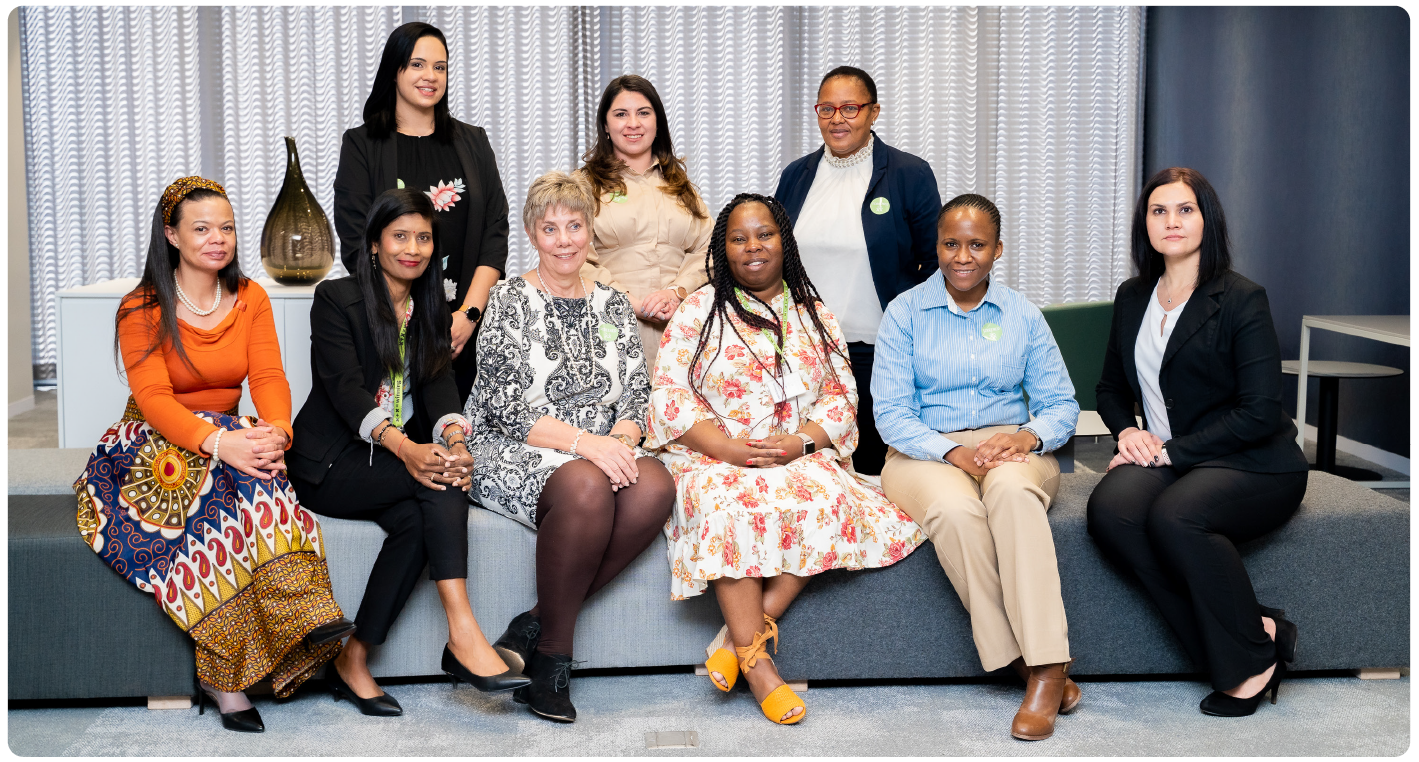
Exxaro's top performing office professionals during our recent recognition awards
Safety remains a top priority for us due to the nature of our operations. We have a moral and legal obligation to ensure that all employees return home unharmed at the end of each workday, and continuously monitor and improve our safety measures.
We uphold our licence to operate through our safety strategy, abiding by basic conditions of employment and ensuring the safety of our people and communities.
Safety is explicitly linked to our strategic objective: make our minerals and energy businesses thrive. To deliver on this, we have an effective safety strategy, supported by our response to safety incidents, reducing as well as eliminating safety-related risks.
We are guided by our safety strategy in our efforts to achieve zero harm, focusing on five areas:

We review the strategy annually and the focus areas have been reviewed and judged appropriate each year since their institution in 2009. We also review our safety targets every year based on prior performance, and apply stringent management protocols, programmes and systems.
While ultimate responsibility for safety lies with our people, accountability for their safety is built into leadership and governance structures, and ultimately rests with the board.
Health and wellness is an executive KPI under the strategic objective: make our minerals and energy business thrive.
In terms of the MHSA and OHSA, our BUs select management and operators as safety and health committee representatives. Each BU tracks adherence to standards and legislation through a safety improvement plan of self-assessments and corporate audits.
Our BU management team investigates all safety incidents, and a skilled committee, headed by an independent chairperson, investigates fatalities and HPIs.
Exxaro reports investigation findings, in particular HPI and fatalities, to the executive committee and RBR committee, and escalates these to our board.
Cennergi prioritises the health, safety and wellbeing of employees and contractors with zero harm as a key objective. We have robust policies and procedures for health and safety, aligned with South African legislation and international standards. Risk assessment and hazard identification are critical in ensuring a safe working environment and mitigation against potential hazards. Cennergi's operations are governed in terms of the Occupational Health and Safety Act, 1993 (Act 85 of 1993) with the CEO and head of operations designated as persons accountable for the health and safety of employees and visitors, and for selecting management and operators as health and safety committee representatives. Our health and safety officer conducts site safety reviews at least once a month. In addition, in terms of our finance agreement and legislation, an independent health and safety consultant conducts external audits every quarter. The group also conducts an annual operations and health, safety and environment external audit.
Cennergi supports local contractors' health and safety requirements as part of our supplier development initiatives. We encourage everyone on our sites to openly report and prevent safety risks. Together with our contractors, we plan to further enhance our focus on safety in 2022.
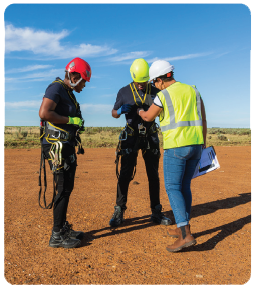
Cennergi's technical and safety team at the Tsitsikamma community windfarm
We conducted corporate safety management standard audits across the group
Our Khetha Ukuphepha campaign continues to play a fundamental role in our efforts to ingrain a sense of personal responsibility for safety across the group
We held BU safety indabas in the third and fourth quarters of 2021, when it was critically important to remain focused on safety
Our Leadership Safety Day led by the Chairperson of the board, took place on 12 October 2021. The importance of the Leadership Safety Day is:
As part of the build-up to this day, each executive committee member has recorded a video message on a specific risk awareness focus area. These recorded messages have been broadcast on virtual platforms across the group since August 2021.
Our annual sustainability summit, which emphasises the importance of safety, was regrettably not held in 2021 due to COVID-19 concerns but will continue in 2022
We analysed serious safety incidents from 2012 to 2021 and lessons learned was communicated across by dedicated executive committee members
We are proud of our safety performance during the year; a true reflection of our commitment to our people's safety.
| Our 2021 safety targets | How we performed | ||
| Zero fatalities | Five consecutive years fatality-free (as at 3 March 2022) | ||
| Zero HPIs | One HPI | ||
| LTIFR of less than 0.08 | 0.08 LTIFR which was on target |
| Safety performance | 2021 | 2020 | 2019 |
| Fatalities | 0 | 0 | 0 |
|---|---|---|---|
| HPIs | 1 | 3 | 0 a 66% reduction |
| LTIs | 12 | 9 | 26 |
| LTIFR | 0.08 | 0.05 | 0.12 |
Cennergi has a strong health and safety record, having achieved zero fatalities since we began operating in 2014.
External compliance audits are conducted quarterly by Safetech. Tsitsikamma community windfarm and Amakhala Emoyeni windfarm achieved average scores of 97% and 98% respectively in 2021.
Two reportable health and safety near misses were reported to the DOL during the year.
In November 2021, an LTI was recorded at Amakhala Emoyeni after a contractor's employee was electrocuted while testing a pads-mounted transformer. We conducted a thorough investigation of the incident, supported by our CEO, head of operations, operations engineer and the various contractors involved. The incident was discussed and reviewed with the Exxaro health and safety team, and the results were shared with the Cennergi and Exxaro boards.
The leading causes of incidents and sources of safety risk have remained consistent from 2012 to 2021. These are:
To highlight these high-risk and high-consequence areas, each cause is assigned to an executive team member. Executives publicly engage with stakeholders across our operations about the importance of care and caution in each instance.
The DMRE issued two section 54 notices (mining activity stopped) and two section 55 notices (mining in affected area stopped) (2020: three), resolved amicably and all activities resumed
No safety-related grievances were raised against Exxaro in 2021
The group performed well compared to industry averages.
G-MIRM
Safety representatives
On the job
Renewable energy business
We rolled out Global Minerals Industry Risk Management (G-MIRM) training for leadership and front-line employees in 2021.
G-MIRM training improves hazard identification and effective decision making.
It also provides a common language for risk management and safety.
We continuously train our safety representatives to empower them.
We provide continuous on-the-job training to ensure well-trained people are in suitable positions.
Every employee and visitor at a Cennergi facility must complete safety induction and mandatory safety training every year.
Cennergi also conducts daily toolbox talks and safe-task instructions, weekly sessions on specific risks and annual safety awareness days.
In addition, two safety indabas were held in October 2021 to entrench safety-related conversations in the company culture.
330 employees participated in G-MIRM training
182 employees attended safety representative training
All employees receive on-the-job training
All contractors at the operation participate in ongoing safety training as part of the induction requirements
G-MIRM
We rolled out Global Minerals Industry Risk Management (G-MIRM) training for leadership and front-line employees in 2021.
G-MIRM training improves hazard identification and effective decision making.
It also provides a common language for risk management and safety.
330 employees participated in G-MIRM training
Safety representatives
We continuously train our safety representatives to empower them.
182 employees attended safety representative training
On the job
All employees receive on-the-job training
All employees receive on-the-job training
Renewable energy business
Every employee and visitor at a Cennergi facility must complete safety induction and mandatory safety training every year.
Cennergi also conducts daily toolbox talks and safe-task instructions, weekly sessions on specific risks and annual safety awareness days.
In addition, two safety indabas were held in October 2021 to entrench safety-related conversations in the company culture.
All contractors at the operation participate in ongoing safety training as part of the induction requirements
In 2022, we aim to continue delivering an encouraging safety performance. Our objectives are to record:

Khetha Ukuphepha, translated as "choose safety", highlights our efforts to achieve zero harm across the group.
As the cornerstone of our zero harm pledge, the campaign ensures that every employee adheres to strict safety standards and returns home unharmed every day.
One of its strategic initiatives is communicating and emphasising the importance of individual safety by educating employees about potential hazards such as machinery, dust inhalation, silicosis, TB and seemingly harmless obstacles like noise or fatigue.

Executive head:
Projects and technology

Executive head:
Stakeholder affairs

Chief risk officer

Executive head:
Sustainability

Executive head:
Human resources

Financial director
Employee health and wellness contributes significantly to improving quality of life, employee morale, productivity and safety performance - all critical for productivity and sustainability in the mining industry.
We uphold our licence to operate through our health and wellness strategy, abiding by the basic conditions of employment and remaining compliant with industry and regulatory standards. Through this, we ensure the health and wellbeing of our people and communities.
We have several measures to ensure the health and wellness of our people and communities, including, among others, our response to COVID-19, foregrounding mental health and consideration of the basic conditions of employment required by legislation. Our health and wellness strategy guides our approach to managing health and wellness throughout the business.
This strategy drives our continued management of health and wellness in the group. It emphasises a preventive and employee-driven approach, and aligns our health and wellness portfolios for a holistic and integrated management programme.
The strategy identifies occupational and non-occupational health risks and their causes, solutions to mitigate these risks, impacts of the risks on the business, and the best approach to ensure an environment that empowers employees to manage and protect their health.
We base our approach to health and wellness on three pillars: prevent, diagnose and manage.
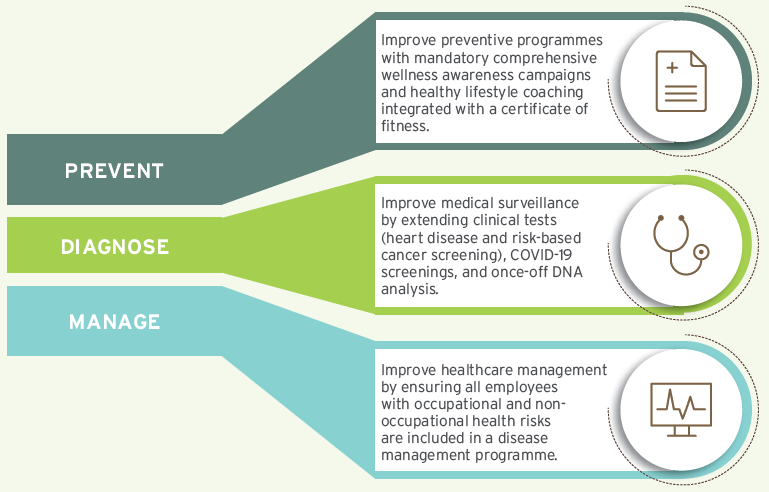

Mobile clinic visits Grootegeluk mine for a breast cancer awareness campaign
Integrated wellness strategy
Exxaro's integrated wellness strategy is a collaborative and holistic approach to employee wellness. It has eight dimensions, and our focus for 2021 was on implementing three dimensions. All employees attend an employee wellness programme (EWP) services awareness session during induction through MyNexxt. The EWP is well established and is key in our EVP. Details on our performance are in EWP.

The board is ultimately accountable for our health and wellness strategy. Responsibility and accountability for implementation is cascaded from executive to mine manager level.
Although the COVID-19 lockdowns were implemented to protect our health, they brought about a level of wellness-related stress and a change in the way we work. In response to this, a key focus for Cennergi in 2021 was to support employee health and wellbeing through the new normal.
We made counselling available to employees, and they were encouraged to use the Exxaro EWP.
We hosted a wellness day in November 2021, where we tested employees' biometrics, blood types and eyes, and provided vitamin shots and dietary advice.
We also celebrated World Mental Health day and Breast Cancer Awareness month when employees received pamper packs.
During the year, we achieved positive health and wellness outcomes. Among others, we successfully managed the impact of COVID-19 on our business, rolled out an employee assistance programme (EAP) and certificate of fitness, and made significant headway in foregrounding mental health issues. Unfortunately, we faced several challenges, including permits for our COVID-19 laboratory and employees' hesitancy regarding vaccines.
COVID-19 remained a significant health risk during the reporting period. Our response, in line with our health and wellness strategy, has prioritised preventing, reducing and managing infections.
As at 31 December 2021, the group had 6 816 confirmed (310 active) cases and a recovery rate of 95%. We remain committed in our fight to prevent further loss of life to implement COVID-19 preventive measures in line with government regulations and recommendations.
| Exxaro | Cennergi | Mining industry | South Africa | |
| Confirmed cases | 6 797 | 19 | 62 519 | 3 603 856 |
|---|---|---|---|---|
| Cases as percentage of workforce | 47 | 21 | 13 | 6 |
| Active cases as at 31 December 2021 | 33 | 0 | 408 | 65 299 |
| Fatalities | 33 | 0 | 744 | 95 022 |
At the start of 2021, we:
On 15 June 2021, the South African government enforced stricter restrictions to curb rising infections. In response, we reinstated previously relaxed initiatives such as:
By mid-December 2020, all BUs had developed their respective return-to-work procedures. BUs drafted these procedures in line with government's guidelines on COVID-19 for employers. BUs also adopted a staggered return-to-work approach to ensure on-site occupational health centres and laboratories were not overwhelmed. In the last quarter of 2020, we doubled capacity of our two laboratories to manage high test numbers.
We conducted rigorous screening and mass testing of asymptomatic and symptomatic employees at entry and intermediary medical examinations.
We also provided oximeters across the group to measure blood oxygen levels and heart rates of employees who tested positive for COVID-19 until they recovered. When there was cause for concern, we alerted our occupational medical practitioner. In addition, our occupational health centres distributed nutritional supplements to infected employees.
Exxaro encouraged employees to use our approved and paid-for quarantine and isolation facilities to recuperate in a safe environment under medical practitioner surveillance.
Our 24-hour COVID-19 call centre, operated by health practitioners, supported infected employees with relevant information and an emergency response service.
On 28 February 2021, government relaxed restrictions as infections decreased but, anticipating the third wave experienced by other countries, we optimised our approach to include a combination of antigen and polymerase chain reaction tests.
Our laboratory at Matla has not yet received a permit to test local community members.
Cennergi developed COVID-19 safety guidelines to ensure the safe operation of our windfarms and a hybrid working model for office-based employees.
Measures implemented at our windfarms included pre-work screening, social distancing, PPE support, staggered shifts for social distancing, body temperature checks, additional portable toilets and regular sanitising.
We also provided PPE, sanitisers and hygiene kits to employees' families.
No Cennergi employee or contractor succumbed to COVID-19.
Cases and vaccination progress were also tracked as part of the Exxaro COVID-19 tracking system.
The human resource department and line managers regularly checked in with teams to address any concerns.
We:
At the beginning of 2021, we embarked on a campaign to further communicate and entrench primary preventive measures. This campaign focused on changing behaviours, such as attending funerals and participating in mass events, which spread COVID-19. These messages were aligned with Exxaro's culture of responsibility and ownership of actions that could lead to infections.
Vaccination highlights
On 11 January 2021, the president announced the country's COVID-19 vaccine strategy, stating that 67% of the population (40 million people) would need to be vaccinated to achieve herd immunity.
The national vaccine roll-out programme began in mid-February with the Sisonke programme using a single dose of the Johnson & Johnson vaccine. A month into the programme, government announced that companies could register for on-site vaccination of employees.
In May 2021, our executive team approved our vaccination programme, in line with government's guidelines, and we purchased the Johnson & Johnson and Pfizer vaccines for our employees, contractors and their families.
Occupational health practitioners
Exxaro's 40 healthcare workers registered with the National Department of Health as vaccinators, and were trained and vaccinated against COVID-19 during the first phase of government's vaccine roll-out programme.
Registration of Exxaro health centres
The Grootegeluk and Matla occupational health centres were registered and approved as primary vaccination sites by the National Department of Health, and received permits in terms of the Medicines and Related Substances Act, 1965 (Act 101 of 1965).
Electronic vaccine data system
Exxaro's occupational health centres have access to an electronic vaccine data system so that employees can be registered as a group by human resources. This ensures that employees are efficiently allocated for vaccination at the appropriate health centre.
As of 31 December 2021, we successfully vaccinated all our healthcare workers, and 74% of employees and contractors. Our vaccination sites were opened to local communities and 2 465 community members were vaccinated.
Communication
We had ongoing communication campaigns and digital masterclasses on vaccination led by our medical health practitioners.
COVID-19 partnerships
The COVID-19 third wave led to public and private hospitals experiencing an influx of patients. In response, we entered into an agreement with Thungela Resources to use their hospital in Emalahleni, Mpumalanga, for employees and contractors needing hospitalisation and treatment.
In collaboration with Limpopo and Mpumalanga health departments, we provide equipment and resources (such as gazebos, chairs and marshals) for on-site vaccine roll-out programmes while the departments supply vaccines, vaccinators and pharmacists.
We also partnered with Dis-Chem to administer vaccines at the conneXXion for employees and their family members in Gauteng.
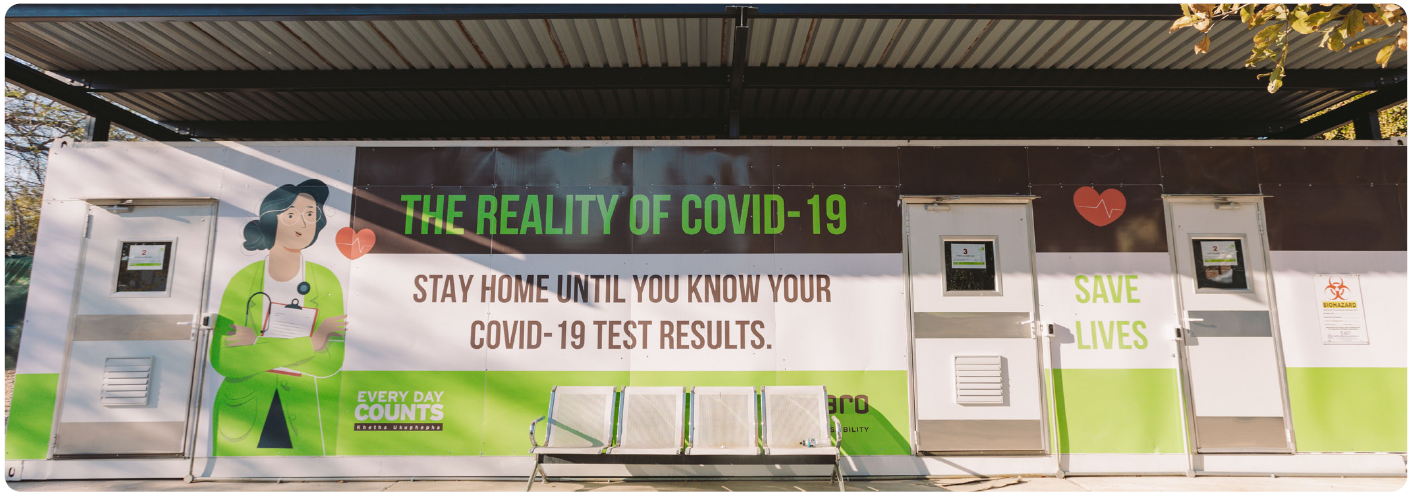
COVID-19 communications at Grootegeluk mine
The EWP is part of the Exxaro integrated wellness strategy. It provides employees with an external counselling service to address psychosocial, legal, financial, emotional, family, work-related and substance abuse issues. These EWP services were extended to contractors at the onset of COVID-19. We also finalised the integration of the certificate of fitness and EWP.
We finalised the integrated wellness strategy and we are busy implementing it. In 2021, three of the eight dimensions were rolled out, namely emotional wellness (through the EWP), financial wellness and occupational wellness, mainly driven by our response to the impact of COVID-19. Financial wellness is supported by Bayport Financial Services and aimed at assisting employees in financial hardship, worsened by the impact of COVID-19. The key services to employees included debt restructuring, financial rehabilitation and providing financial skills (budgeting). Occupational wellness is covered through our sustainability response to COVID-19 at BU level. We will implement the remaining six streams in 2022.
Problem profile
Mental health and wellbeing was the top category presented to the EWP and accounted for 53.6% of all cases. Stress was the top problem to the EWP.
Utilisation
The group's wellness utilisation rate for the year was 15.82%. This is higher than the previous year (10.15%), the mining sector (7.67%) and the Life EHS Benchmark (9.47%).
Referral source
Management referred 167 employees to the EWP during the year; 18 group trauma interventions were requested and the remaining cases were linked to self-referrals. Seventy-four dependants accessed the EWP.
Services accessed
Face-to-face counselling was the top service accessed during the year.
Demographics
More men than women used the EWP during the year. The ages of people using the programme ranged from 14 years to older than 50. English was the most commonly used language for counselling.
Although employees were using the service, we launched a campaign on 15 January 2021 to make the EWP services more visible and accessible to employees and contractors. The phased campaign included the following:

Awareness:
We advertised EWP offerings on LetsConnect, LCD screens, screensavers and the intranet. We also introduced mental health masterclasses on Microsoft Teams every second Friday for employees to learn about mental health issues and practical techniques to self-diagnose and cope with challenges. We shared daily inspirational messages via SMS for 30 days and signed off with EAP contact details.
#You'reNotAlone:
In February 2021, a voicenote and video series was introduced. This showcased employees across the group sharing their battles with mental health issues and the comfort they found in speaking to a counsellor or therapist.
Integration of the EWP and certificate of fitness:
An EWP awareness module was developed as part of employee induction on the Exxaro learning platform.
Our approach to mental health incorporates World Health Organization principles. COVID-19 highlighted the extent and significance of mental health issues in the workplace. Disruptions to regular working routines, fear of loved ones contracting the virus and uncertainty about the future can all affect mental health.
We rolled out a series of masterclasses this year, aligned to our integrated wellness strategy, addressing our employees' financial, emotional, social, cognitive, occupational, environmental and spiritual wellbeing.
Employees who were concerned about their mental health were also encouraged to use the EWP.
We categorise occupational diseases contracted at work as communicable and non-communicable. Communicable diseases are contagious (passed from one person to another) such as occupational TB. Non-communicable diseases such as noise-induced hearing loss (NIHL), chronic obstructive airways disease (COAD), silicosis, dermatitis, asbestosis and work-related limb disorders are not contagious.
Exxaro recorded one non-communicable disease case (asthma) in 2021.
Mitigation measures to prevent the spread of COVID-19 helped decrease occupational diseases from 32 in 2020 to 25 in 2021.
| 2021 Exxaro | 2020 | 2019 | 2018 | 2017 | |
| NIHL | 4 | 1 | 11 | 11 | 12 |
|---|---|---|---|---|---|
| Pneumoconiosis | 5 | 1 | 2 | 8 | 18 |
| Silicosis | 0 | 0 | 1 | 0 | 0 |
| COAD | 2 | 3 | 2 | 4 | 1 |
| Occupational TB | 13 | 27 | 35 | 42 | 26 |
| Occupational asthma | 1 | 0 | 0 | 0 | 0 |
| Total | 25 | 32 | 51 | 65 | 57 |
Four occupational disease cases (demonstrably work-related) (2020: six) were accepted for compensation in 2021, including three (2020: five) Occupational TB and one (2020: one) pneumoconiosis.
We aim to meet mining industry targets set in 2014 to eliminate NIHL, silicosis and pneumoconiosis, as presented below.
NIHL
No employee's standard threshold shift will exceed 25dB from the baseline when averaged at 2 000Hz, 3 000Hz and 4 000Hz in one or both ears
Silicosis
By December 2024:
Pneumoconiosis
By December 2024:
HIV/Aids and TB
By December 2024:
Current status
Previously unexposed individuals were not exposed to mining dust before December 2008 (equivalent to a new person entering the industry in 2009).
NIHL cases remained at three, indicating that the group successfully implemented the programme. The programme will be reviewed in 2022 for further improvements to eliminate cases.
Identified TB and HIV/Aids cases decreased in 2021 due partly to our approach to TB with contact tracing measures and active management of employees on treatment.
HIV/Aids awareness among employees is part of medical induction. Contractors attend awareness programmes during specific campaigns and, since the beginning of 2021, during medical inductions.
HIV/Aids campaigns across the group encourage voluntary counselling and testing. Exxaro ensures that HIV-positive employees can easily access medication at occupational health centres.
| HIV/Aids awareness (employees and contractors) | 2021 | 2020 | 2019 | 2018 |
| Attended information sessions | 19 586 | 17 693 | 30 403 | 18 657 |
|---|---|---|---|---|
| Total tested | 12 143 | 8 475 | 12 679 | 9 492 |
| % tested | 61 | 48 | 54 | 77 |
| Employees tested positive | 457 | 746 | 578 | 356 |
| Enrolled at December (cumulative) | 5 054 | 4 554 | 5 342 | 4 475 |
| Received antiretroviral treatment | 5 897 | 5 848 | 5 124 | 3 167 |
The number of people attending awareness sessions increased in 2021 due to HIV campaigns.
The prevalence of HIV/Aids cases among full-time employees is 3.6%. The national prevalence rate is 13.7% (as at 31 July 2021).
In total, four cases have been accepted for compensation. These include one case at Matla and three at ECC*.
* Divestment concluded in September 2021.
We categorise lifestyle (non-occupational) diseases as communicable and non-communicable. Communicable lifestyle diseases include cholera, malaria, typhoid, influenza and sexually transmitted infections including HIV/Aids. Non-communicable lifestyle diseases are mainly diabetes, hypertension and cardiovascular ailments.
In 2021, we identified 39 new diabetes cases (2020: 70) and 290 hypertensive employees and contractors (2020: 196).
When managing malaria, Exxaro provides prophylaxis to employees and contractors in affected areas.
No health and wellness-related grievances were reported in 2021.
We report against the industry TB and HIV targets on the Minerals Council's Masoyise dashboard.
As part of annual induction training, 10 927 employees and contractors received HIV/Aids awareness training and 2 836 employees and contractors received noise and hearing awareness training.
We will continue implementing our health and wellness strategy in 2022, increasing medical offerings for employees at all levels to include electrocardiogram tests. We will also work towards a wearables strategy to manage occupational health data.
As the importance of wellness has been highlighted by COVID-19, we expect integration of wellness-focused ways of working to increasingly become the norm with improved health and wellness practices working to overcome challenges in the global response to the virus.

On-site lung testing at Matla mine clinic
Ensuring our employees are engaged actively supports the best interests of our business, host communities, society and the environment. Engaged employees are productive and focused, which enhances safety and supports business stability. Engaging with our employees helps us understand their material needs and concerns to respond accordingly, maintain our EVP as an employer of choice, and attract and retain key talent.
We uphold our licence to operate through our established engagement structures, union recognition agreements, compliance with DMRE requirements, and ongoing consultation and negotiation.
We believe that our success in delivering on our strategy lies in the strength of our culture and values. To ensure these are successfully embedded across the business, we have an effective employee relations strategy, supported by engagement structures, recognition agreements and frameworks.
Our employee relations strategy guides our approach to managing employee needs and expectations to maintain a healthy and productive workplace. Employee engagement is mainly managed through BU and employer-based structures where we engage with recognised trade unions. We also have broader structures for employee engagement which include community and contractor engagement forums. We also have engagement structures in support of our diversity and inclusion strategy which include women in mining and transformation forums.
The employee relations strategy is premised on proactively engaging and dealing with employee issues through formalised structures to ensure adequate feedback and resolution. We encourage our leadership to keep abreast of the employee relations climate through continuous interactions with employees, communities and unions.
Our well-embedded values and empowered culture form the very core of our organisation and define how we work, interact, behave and respond to issues. Further, they filter into the positive work we do to better society.
Our values guide our behaviour at Exxaro

These are underpinned by our culture
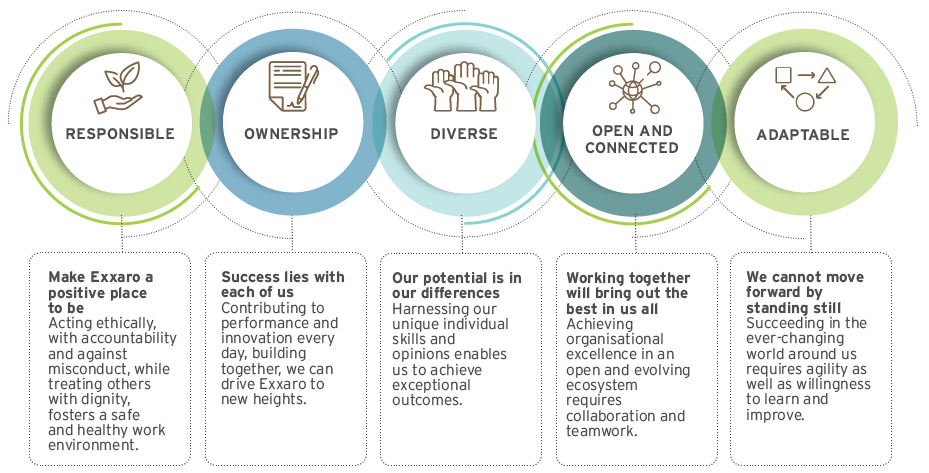
Our adaptable culture reflects our willingness to learn and improve as we strive to achieve our strategy. We continue intensifying our employee engagement efforts to share critical information and changes. This includes feedback from our employees through our culture and engagement survey.
The SERC is ultimately accountable for and oversees employee engagement. The executive head: human resources is responsible for implementing engagement initiatives. We see our culture as a leadership responsibility across the business, from executive level down, driven by employees and leaders. Additionally, BU managers and teams drive our culture at operations.
In a year marked by initiatives promoting wellness, values of diversity and equity, and the strategic shift towards decarbonisation as a priority, it was essential for us to ensure that our culture supports and is accentuated by those initiatives. In particular, the work done in health and wellness, gender diversity and equity present opportunities to embed and foreground our culture.
Our corporate culture is crucial in determining our success today and in years to come. We aim to foster a culture that supports adaptability and innovation, leveraging the strength of diversity to enable our success.
Our culture themes demonstrate our commitment to achieving the goals of our decarbonisation strategy, purpose and vision. In 2020, we adopted an integrated approach to culture, adapting our COVID-19 response and embedding culture themes into existing programmes (such as health and safety, sustainability, diversity and inclusion, social impact, Exxaro Leadership Way and various monthly activities) so that required behaviours would resonate among employees. Messages were further aligned to the activities in our corporate communications calendar. This included supporting employees in remote working, mental health and emotional issues, anti-stigmatisation, women empowerment and gender-based violence (GBV), among others.
Lack of social contact posed some challenges in implementing culture initiatives. Nevertheless, we adapted to electronic and hybrid approaches that allowed us to roll out our continuous culture engagements as planned. Our digital communications platforms (SMS/mobile platform and LetsConnect) enhanced our ability to communicate key culture messages and for employees to have better access.
Our cultural values and themes extend beyond our internal environment to external interactions and stakeholder partnerships.
We conducted a baseline culture and engagement survey in 2020 to track the efficacy and progress of organisational culture, and to pinpoint areas in need of improvement. This continuously improves our employment experience as we live our values with leadership support.
In 2021, the business implemented actions to ensure improvements in the identified key focus areas, which included:
We will continue to monitor this process once every two years, with the intervening years used to incorporate learnings. Our next survey for comparative analysis will be conducted in 2022.
Our approach to organised labour relations is defined by collaboration and constructive engagement. Union relationships are based on trust and integrity.
Our employee relations strategy enables us to proactively maintain a healthy workplace through established engagement structures and dispute resolution mechanisms based on fairness. This strategy is being reviewed to ensure it remains applicable in workplaces and engagement mechanisms that have changed due to COVID-19.
Exxaro's policies and procedures comply with best labour relations practices and relevant legislation. We manage individual and collective employee concerns with due respect.
We conduct skills workshops and training for employee relations managers and line managers to ensure that all parties are committed to building solid relationships. We broaden our employee relations capacity building processes to understand recognition agreements and their purpose.
Union representation
In 2021, 5 180 employees were represented by affiliated unions recognised by Exxaro, being NUM, Solidarity, AMCU, FAWU and NUMSA (2020: 5 119). However, UASA and Solidarity lost bargaining rights in 2021 at Exxaro Coal Mpumalanga Proprietary Limited as they did not meet the threshold requirement.
| Number of employees | |
| AMCU | 333 |
|---|---|
| FAWU | 44 |
| NUMSA | 54 |
| NUM | 4 367 |
| Solidarity | 363 |
| UASA | 0 |
| Total | 5 180 |
We maintain good relations with employees in bargaining units by engaging with their representative unions through formal structures. Wage negotiation processes are conducted at employer level, and these engagements determine negotiated conditions of employment. In 2021, Exxaro embarked on wage negotiations processes across five employers and concluded long-term (three-year) wage agreements for bargaining unit employees within these employers. These long-term wage agreements provide a measure of labour stability across the group for the next three years.
We concluded multi-year wage agreements for Exxaro Coal Proprietary Limited, Exxaro Coal Mpumalanga Proprietary Limited, FerroAlloys Proprietary Limited, Ferroland Grondtrust Proprietary Limited and Coastal Coal Proprietary Limited after their wage agreements expired in June 2021.
Share ownership
Greenshare, our employee share ownership plan (ESOP), was developed for qualifying employees in 2019 and implemented in 2020. The scheme is evergreen and beneficiaries will benefit from dividend payments only for the duration of employment. This scheme is open to all employees not participating in any management share scheme.
When dividends are declared, participants in service will receive a cash payment equal in value to 560 Exxaro shares minus dividend tax. Participants will remain in the scheme for the duration of employment. Employees will not have capital appreciation rights.
| Number of active beneficiaries |
Number of units | Payment amountbefore tax (R) | Payment amount after tax (R) |
|
| March 2021 | 6 210 | 3 477 600 | 62 109 936.00 | 49 687 948.80 |
| August 2020 | 6 287 | 3 520 720 | 73 125 354.40 | 58 500 283.52 |
| In 2021 each beneficiary in Greenshare received a cash payment of R17 306.24 | ||||
The diversity and inclusion strategy is a key conduit for successful delivery of our business strategy, as it enables us to positively grow and harness the diverse talent across our company. The delivery of the diversity and inclusion strategy is managed through a framework which ensures adequate focus and momentum on key transformation milestones.
Our commitment to diversity and inclusion aligns with our values and culture to achieve our purpose. To support this commitment, our diversity and inclusion policy was approved in 2021.
This policy is built on the premise of equity that ensures:
The objectives of the policy are that Exxaro:
Although ultimate accountability for diversity and inclusion resides with our board, the policy stipulates that the board has delegated authority to the CEO and executive committee to act on its behalf in matters relating to diversity, equity and inclusion. The board will monitor diversity, equity and inclusion activities through the CEO and the executive head: human resources.
It further outlines roles, responsibilities and penalties for non-compliance.
Policy alignment and review positively supports our diversity and inclusion journey. Creating an enabling environment free from any form of harassment and discrimination is the cornerstone of greater organisational inclusivity.
The policy was reviewed in 2021 and provides guidance as well as regulates the management and prevention of sexual and racial harassment in the workplace. The policy also assists in defining and creating awareness on matters pertaining to sexual and racial harassment.
Our policies and skills development enable us to meet our transformation objectives in support of the national imperative for a non-racial and transformed society. Appropriate affirmative action measures and human resource development programmes support our transformation processes and cultural engagements.
We have achieved our employment equity targets over the past five years. Our targets for 2019 to 2022 align with the Mining Charter III. Through our diversity and inclusion initiatives, we have been able to make good progress in women representation at senior management level. This occupational level has been a challenge in the past. We aspire to measure our transformation profile against national economically active population statistics.
Our annual employment equity actual versus target set by DMRE.
| Employment equity in 2021 | Black males | All females | Historically disadvantaged people1 |
DMRE targets | ||||||||
| Management category | Number | % | Number | % | Number | % | Historically disadvantaged people target |
Women target |
||||
| Top management | 1 | 33 | 1 | 33 | 2 | 66.67 | 50% | 20% | ||||
|---|---|---|---|---|---|---|---|---|---|---|---|---|
| Senior management | 36 | 43.37 | 17 | 20.48 | 53 | 63.86 | 60% | 25% | ||||
| Middle management | 248 | 39.94 | 235 | 37.84 | 483 | 77.78 | 60% | 25% | ||||
| Junior management | 1 206 | 50.61 | 696 | 29.21 | 1 902 | 79.82 | 70% | 30% | ||||
| Disabled | Performance of 1.6% for all employees against a target of 1.5% for all employees | |||||||||||
1 Includes white female employees.
There has been an increase in women representation, especially in senior management. This reflects ongoing work and commitment to ensure appropriate representation aligned with DMRE targets.
In 2019, Cennergi developed a five-year employment equity plan in line with legislation and the DEL's codes of good practice. Cennergi's employment equity committee oversees the plan's implementation, and guides and monitors transformation and skills development. It reviews the recruitment process, follows up on deviations in employment equity performance, and monitors the technical skills required to reach transformation goals.
The IPP office tracks Cennergi's employment opportunities for equity categories under the Renewable Energy IPP Programme. Equity categories with contractual commitments include employment secured for South African citizens and local communities.
Amakhala Emoyeni committed to hiring 97% South African citizens (77% black and 64% from local communities). Tsitsikamma is committed to hiring 80% South African citizens (50% black and 20% from local communities).
The implementation agreement signed between the DMRE and the two SPVs stipulates that IPPs are obliged to report job creation obligations to the DMRE quarterly with proof. There are penalties and rewards, based on quarterly performance, with underperformance drawing termination points, which could accumulate to the point where the DMRE is entitled to terminate the contract. By imposing these penalties, the DMRE ensures that bidders show an ongoing commitment to enterprise development objectives rather than falsifying pledges to win bids.
Cennergi consistently met its job creation targets and incurred no termination points or penalties in 2021.
Exxaro was certified as a level 2 BEE contributor in 2021, retaining our empowerment level and status as one of South Africa's largest and foremost black-empowered and diversified mining companies. We will continue to pursue our targeted level 1 contributor status.

Belfast mine management team meeting prior to COVID-19 pandemic
In 2021, Exxaro's average employee turnover rate was 3.7% due to death, resignation and dismissal (2020: 3.6%). The turnover rate by employee group is as follows:
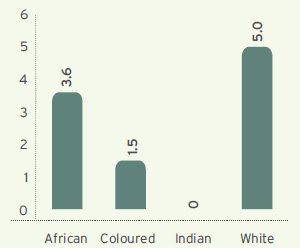
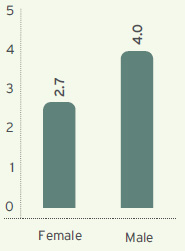
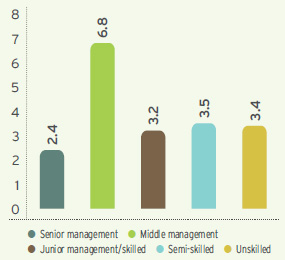

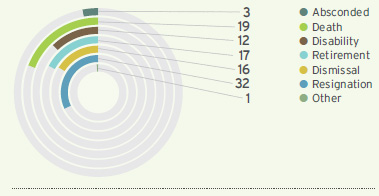
We had 6 745 employees in 2021 (2020: 6 739) with 81.93% in bargaining units (2020: 82.92%) and 18.03% in the management and specialist category (2020: 17.08%).
| Bargaining unit | Corporate non-management and specialist | Management and specialist | ||||||||||||||
| Female | % of workforce |
Male | % of workforce | Female | % of workforce | Male | % of workforce | Female | % of workforce |
Male | % of workforce |
Total | ||||
| Eastern Cape | 0 | 0.00 | 0 | 0.00 | 1 | 0.01 | 1 | 0.01 | 2 | 0.03 | 4 | 0.06 | 8 | |||
|---|---|---|---|---|---|---|---|---|---|---|---|---|---|---|---|---|
| Foreign | 1 | 0.01 | 36 | 0.53 | 0 | 0.00 | 0 | 0.00 | 2 | 0.03 | 6 | 13.33 | 45 | |||
| Gauteng | 12 | 0.18 | 58 | 0.86 | 63 | 0.93 | 27 | 0.40 | 148 | 2.19 | 168 | 35.29 | 476 | |||
| KwaZulu-Natal | 22 | 0.33 | 39 | 0.58 | 0 | 0.00 | 0 | 0.00 | 0 | 0.00 | 2 | 3.17 | 63 | |||
| Limpopo | 770 | 11.42 | 2 296 | 34.04 | 2 | 0.03 | 0 | 0.00 | 135 | 2.00 | 358 | 10.05 | 3 561 | |||
| Mpumalanga | 502 | 7.44 | 1 808 | 26.81 | 0 | 0.00 | 0 | 0.00 | 100 | 1.48 | 182 | 7.02 | 2 592 | |||
| Total | 1 307 | 19.38 | 4 237 | 62.82 | 66 | 0.98 | 28 | 0.42 | 387 | 5.74 | 720 | 10.67 | 6 745 | |||
We are committed to equal opportunity, irrespective of race, religion, gender, health status, sexual orientation or nationality. We believe that our diversity and differences strengthen our potential. We embrace the diversity of our strengths and individual skills to enable exceptional outcomes and promote a culture of inclusivity.
Our values guide our behaviour that celebrates the power of diversity and inclusion. Discrimination is never acceptable. Exxaro invests in upskilling and training managers and supervisors to appropriately apply necessary disciplinary measures.
In the review period, no cases of alleged discrimination or grievances were filed (2020: none).
In line with our Mining Charter III obligations and our business needs, we address home ownership under our long-term housing strategy and encourage home ownership among our employees.
Since 2009, 1 165 permanent employees have received a mortgage repayment subsidy for first-time home buyers. Capital assistance of R125 000 significantly reduces employees' mortgages and improves affordability.
Our converted hostels (single-quarter accommodation or family units) are not fully occupied with 75 employees living in these facilities. By 2025, Exxaro intends to withdraw support for hostel residents.
In addition, bargaining unit employees receive a housing or living-out allowance. In 2021, we paid a housing allowance to 1 436 employees with a registered bond (2020: 1 810) and a living-out allowance to 3 329 employees renting accommodation (2020: 3 450).
Exxaro complies with the Basic Conditions of Employment Act which regulates the working hours and all labour legislations of South Africa. We have aligned our policies to laws of the country.
We subscribe to the precepts and standards of the International Labour Organization.
We will continue to pursue employment equity targets while we compile an anti-bullying policy and finalise our employee relationship management strategy in collaboration with unions. In support of the Sustainable Growth and Impact strategy, we will be implementing related STI targets.

Finance Director, Riaan Koppeschaar after his vaccination
From April 2021, Exxaro rolled out a COVID-19 vaccine communications and change management campaign on various internal
communications platforms in four phases:
Phase 1: The history of vaccines awareness campaign began on 19 April. Content was published on LetsConnect and LCD screens.
Phase 2: The 10 truths about the COVID-19 vaccine (debunking myths) ran from 26 April to 7 June on LCD screens, SMS (via
LetsConnect), lock screens and the second quarter newsletter.
Phase 3: Testimonial videos (including the CEO being vaccinated and some health workers sharing their vaccination experiences)
ran from 17 May to the end of July. The content was released via LetsConnect and the intranet.
Phase 4: "Ask a COVID-19 vaccine-related question" was implemented via LetsConnect from 19 April to 14 May.
The COVID-19 24-hour call centre was pivotal in sharing vaccine information, responding to employees' queries and concerns, and providing overall support in the understanding and management of the pandemic across the group.
To encourage vaccination, employees also receive recordings of our CEO and other executive team members receiving their vaccines.
| Our ability to deliver on business objectives and ensure business continuity depends entirely on our ability to attract, develop and retain people with the right skills profile aligned with our strategy. | We uphold our licence to operate through our talent management strategy that ensures that our employees are skilled, in the correct positions, and challenged and engaged in taking ownership of their careers. | ||
|---|---|---|---|
Talent management encompasses a wide range of activities that impact business performance and continuity. These include strategic workforce planning, leadership and capability development, compliance training and reporting, and managing a sustainable and healthy leadership and talent pipeline. Our talent management strategy ensures that our business has the right skills, at the right time, in the right place. This is done through robust talent acquisition processes and succession planning and talent review processes from BU level through to the functional and executive level. We aim to ensure workforce continuity by identifying and preparing suitable internal candidates for positions while building a leadership pipeline for critical positions.
The talent strategy is evolving to support capability development of our workforce in line with Exxaro's strategic objectives and new ways of work.
Given the challenges presented by the COVID-19 pandemic and lockdown regulations we enhanced our talent offering by digitalising learning and using technology to give better access to learners.
Our succession planning process for management and specialists employees identifies and develops Exxaro's future leaders. We use succession plans to address the inevitable changes that occur when employees are promoted, rotated, exited or retire. Our talent bench is tracked so that we can monitor our talent pipeline to ensure we continue developing employment equity candidates and that we have proactive measures that address talent and critical skills shortages. Our talent bench for employment equity is 26.3% on the D band and 30.8% on the E band.
Initiatives included:
These initiatives help enable a continuous learning environment by reducing standard times of compliance learning, while enhancing opportunities for development training and job enrichment. We continue to grow the learning offering through Exxaro's capability learning catalogue. The capabilities form the basis of our competitive advantage and help us focus on what we need to be successful.
Cennergi prioritises internal recruitment of high-potential people to retain valuable talent and promote the growth of its management service expertise.
STI rewards are offered to employees, based on individual and company performance.
Cennergi spends 1% of its payroll on training and development of its employees. Despite face-to-face restrictions due to COVID-19, many of our employees attended personal development training in 2021.
Our employees meet biannually with their line managers for performance appraisals, and to discuss training and development needs.

Training in progress at Matla mine
We invested significantly in our people through learning and development initiatives and on-the-job training. COVID-19 regulations restricted traditional learning, recruitment and selection for learnerships, PIT, bursars and internships and this ultimately affected us meeting the SLP commitments and targets. We were able to mitigate some of the effects by offering virtual learning through MyNexxt. It provides blended learning and e-learning instead of the traditional classroom method. Our assessment and recruitment processes were digitalised to include interview guides, online interviews and online assessments. We continue investigating hybrid training models to provide flexibility while improving the EVP for learning and development opportunities.
Spent R276 million on training
Contracted nine full-time people with disabilities (PWD) students
121 employees attended various leadership programmes
Enrolled 201 employees in management programmes
Invested R1.02 million in adult education and training
Supported 28 full-time bursars
85 PITs in the talent pipeline
54% of bursaries awarded to full-time female students in engineering and mining disciplines
We spent R276 million or 5.8% of our payroll on training and development this year (2020: R227 million or 5.04%), including:
| Human resources training expenditure | 2021 | 2020 | 2019 |
| Total training (Rm) | 276 | 227 | 298 |
|---|---|---|---|
| Total training (% of total payroll) | 5.8 | 5 | 7 |
| Training of black people (Rm) | 222 | 177 | 219 |
| Black people trained (% of total payroll) | 4.67 | 4 | 5 |
In 2021, we appointed 25 external Paterson* D (middle management) band candidates (100% black; 44% black female) and 48 internal candidates (90% black; 33% black female). On the Paterson E (senior management) band, we appointed three black candidates (100% black; 33% black female) and four internal black candidates (100% black candidates; 25% black female). The high internal placement rate shows a well-managed succession planning and development process by leadership.
* Paterson levels refer to remuneration levels.
Future planning for the minerals and energy businesses pipeline is underway with the creation of new development programmes. Over the past four years, we have aligned our recruitment efforts to our overall employment equity targets, driving us to be more representative of national demographics.
There is a shortage of candidates in certain disciplines at universities for bursary and PIT programmes especially in the mechanical and electrical disciplines, thus stressing the importance of recruiting individuals earlier in their studies period. We are committed to identifying new learners from our host communities. We recruit second and third-year, full-time university students to increase our effectiveness in managing a pipeline. We recruit in core engineering, IT, geology and support service disciplines, among others and have introduced new disciplines for broader coverage of our business functions.
The strategic workforce planning division is responsible for workforce planning over the medium to long term. Its key focus is to use workforce planning market data to give input into talent sourcing and development strategies and ensure capability frameworks are created and aligned to the new growth strategy.
Since 2018, the division has worked closely with business leaders in coal operations to create opportunities that will drive early value creation for the minerals business and help map out the roles that will transition in a digitalised environment. The result of this was a new capability catalogue aligned to the Digital@Exxaro strategy and a new learning platform.
We recently started engaging with stakeholders from our minerals and energy businesses about their workforce requirements. Mapping competencies to new learning interventions will allow employees to reskill and upskill according to the business strategy.
Succession planning ensures workforce continuity by identifying and preparing suitable internal candidates for positions while ensuring a sustainable leadership pipeline for critical positions through talent mapping. The cluster health across D and E Paterson bands is satisfactory with 30.8% of the E Band and 26.3% of the D Band clusters having Black employees that are immediately or medium term ready for the next higher-level position. Our robust annual succession planning cycle runs through talent reviews across BU and functional forums.
We strive to create a learning culture for our employees, and ensure compliance with safety, health and environment requirements, using the e-learning platform as well as classroom-based training.
In 2021, employees completed more than 80 303 training interventions on the MyNexxt e-learning platform. In addition, leadership and management, soft skills, occupational programmes, and technical training was provided by either formal academic institutions, service providers and/or our Grootegeluk and Matla training centres (accredited by the Quality Council for Trades and Occupations).
Employee development is an ongoing process and is guided by the internal company processes of performance achievement, career and succession planning, culture and leadership initiatives and Mining Charter III commitments on the SLP targets. Through these processes employees receive an individual development plan and the organisation ensures a healthy talent pipeline of core and critical skills.
Exxaro submits the workplace skills plan and annual training reports to the Mining Qualification Authority as well as reports to the DMRE and dtic as part of the annual compliance reporting cycle. Information on training spend and number and type of training interventions is provided against each race, gender and occupational category group.
Our formal learnerships and feeder schemes allow us to train and develop young people with formal qualifications in skilled jobs such as artisans, miners and operators of trackless mobile machinery, plant and administration. We recruit young people from our communities and provide employment opportunities through formal programmes. This ensures a feeder line of trained and skilled people when we have vacancies.
| In training | Black people | Black women | ||
| Engineering learners | 485 | 447 (92%) | 206 (42%) | |
| Miner learners | 61 | 61 (100%) | 39 (64%) | |
| Operator learners | 163 | 162 (99%) | 83 (51%) | |
| Internships | 157 | 156 (99%) | 82 (57%) | |
| Business administration learners | 16 | 16 (100%) | 16 (100%) | |
InternshipsInternships provide the opportunity to establish a feeder scheme for C band positions in Exxaro. Interns are young graduates who receive work experience in their field of study within a structured training programme. This also addresses the need for young people to gain work experience and improve their employability. |
||||
Adult education and training intends to ensure employees reach NQF level 1 qualification (grade 9). This ensures employees are functionally literate, improving safety and health communication as well as opening the door for further development and access to jobs where literacy is required.
| 2021 | 2020 | ||
| Investment (Rm) | 1.02 | 0.7 | |
|---|---|---|---|
| Number of employees enrolled | 3 | 9 | |
| Number of community members enrolled | 89 | 62 | |
| Number of qualified employees since programme inception | 1 300 | 1 300 | |
|
Interest in adult education and training (2% of our employees) is low due to the age profile of our workforce. As an alternative, we offer portable skills training in welding, plumbing and civils. 108 employees enrolled in portable skills as alternative. |
|||
New capability development and preparing employees to perform competently in the changing world is one of our key objectives for talent management.
Capability development initiatives in 2021 included:
We rolled out customised leadership programmes and management training, mainly targeting package category employees. In 2021, 121 employees attended various leadership programmes and 201 were enrolled in management programmes. The Leadership in the conneXXion Economy is Exxaro's flagship leadership development programme for middle and senior level leaders. This programme is accredited with the North West University and it pitched at the NQF level 7.
To support the Exxaro Leadership Way initiative, an e-book was made available for employees on MyNexxt.
Mentorship and coaching programmesTo support leadership development, we offer mentorship and coaching to employees aspiring to leadership positions. In 2021, 32 employees formed part of the 24-month mentoring programme. 78% were black people and 41% black females. |
Fast-tracking programmesWe placed 64 D and E band high-potential employees in the fast-tracking programme (98% black people and 48% black female). Within two years, 26% of employees on this programme were promoted. Eight high-potential E band employees are being developed in the executive mentoring programme. |
||
|---|---|---|---|
Formal studiesThe talent management division continues to work closely with universities and technical colleges, influencing syllabus change and aligning to Industry 4.0 concepts. To date, we have included new modules in engineering graduate programmes (modular and agile lean construction, complexity management and design thinking with focus on digitalisation). There were no new enrolments for postgraduate studies in 2021. The executive committee approved enrolments in 2022 for functional disciplines as well as programmes aligned with the new business strategy (eg renewable energy, sustainability and digitalisation). In 2021, we started incorporating short courses in new competencies required for the new way of work from various tertiary institutions. |
Bursary and graduate programmeAs part of the diversity and inclusion strategy of creating a more inclusive culture and fulfilling the compliance training targets for PWD, we awarded bursaries to black South African PWD students at tertiary institutions (56% black women). These graduates will receive formal training and assigned mentors will oversee their development programmes. In 2021, we supported 28 full-time bursars at South African universities at a cost of R2.4 million. 100% of our bursars were black South Africans and 54% were black women. |
||
|---|---|---|---|
Our three-year PIT programme blends academic theory with hands-on workplace experience. We pair each graduate with a technical coach who supervises exposure to various operations as well as technical, leadership and management training. After three years, we guide trainees who meet the requirements for accreditation to become professional engineers.
In 2021, we had 85 PITs in the talent pipeline at a cost of R45.4 million. 85% of our PITs are black South Africans and 41% are black women. The PIT symposium held on 7 October 2021 was a hybrid event attended physically by some executive and senior leaders while the rest of the audience joined online. The theme "Ikusasa Lanamuhla – Journey to tomorrow" aligned with Exxaro's purpose to power better lives in Africa and beyond.
Matriculant supportEdumap College provides a bridging programme for students from disadvantaged communities in South Africa. Matriculants with academic potential and who do not meet university entrance requirements are identified for a 12-month bridging programme to upgrade their mathematics and physical science skills. We sponsored 10 students in the 2021 programme. |
Entry-level employeesThe gamified online assessment (Odyssey), which looks at basic readiness for entry into the world of work, was introduced in 2021 for entry-level positions. A dynamic risk assessment assesses tolerance of risk-based behaviours. |
||
|---|---|---|---|
We proudly support active women in mining structures across our operations, in collaboration with transformation structures, that highlight and resolve issues affecting women in the workplace.
We empower female employees who make up 26% of our workforce (2020: 24%). We grow this talent pipeline through our PIT programme, which enrolled 41% female candidates in 2021 (2020: 38%).
In 2021, 54% of bursaries were awarded to full-time female students in engineering and mining disciplines at universities in South Africa (2020: 39%).Our learnership and internship feeder schemes in 2021 comprised 51% women (2020: 40%).
Exxaro is recognised as a leader in gender empowerment as we understand the barriers women face in the mining industry. Our initiatives include:
We focus strongly on employment equity plans to increase the number of African females in our feeder schemes and talent pipeline. We sponsored 23 African females at the TVET college to improve opportunities for access to formal learnerships such as artisan training.
In 2021, we had 56% African females with full-time bursaries, 41% PITs, and 51% learners and interns.
No formal grievances and no dissatisfactions were reported.
Further details of Exxaro's accolades are outlined in our ESG perspective.
In 2021, we established relationships with five online open-source, local and global learning platforms (LinkedIn, Udemy, Coursera, OTT University and Open Sesame). This contributes to Exxaro's EVP and our objective to put learning development back into the hands of the employee. It will be implemented in the first quarter of 2022.
Our continuing talent management focus in line with the people strategy for 2022 will comprise:
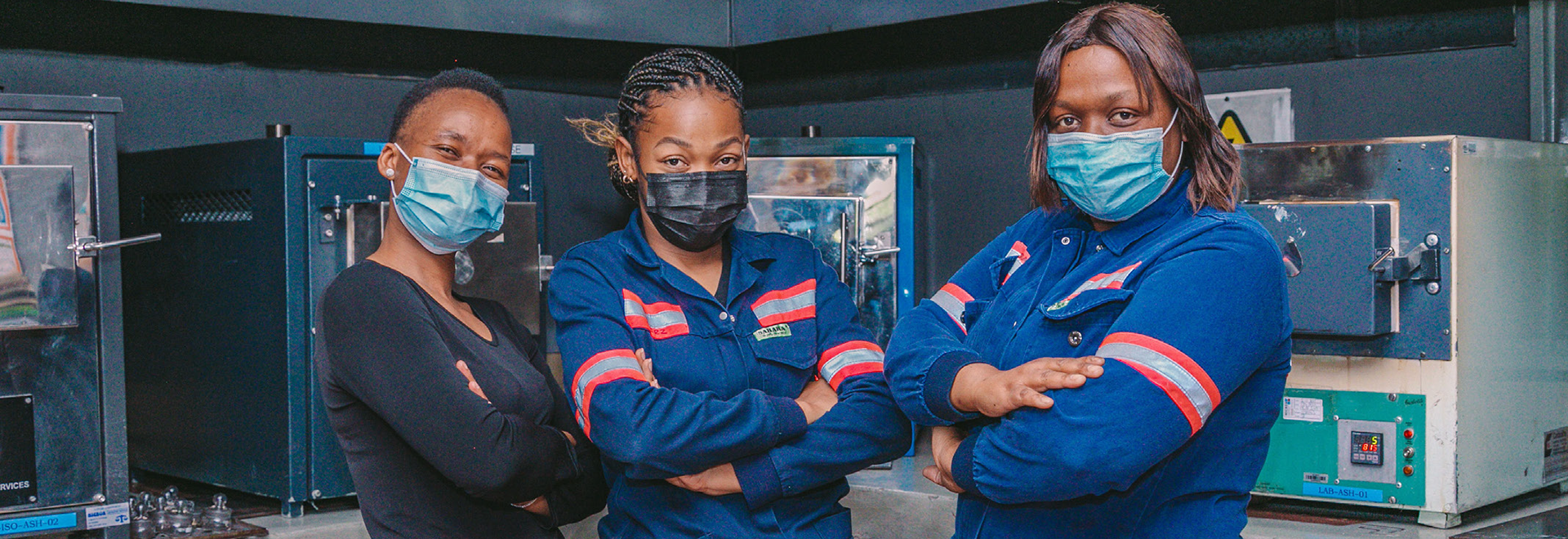
Exxaro's women in mining
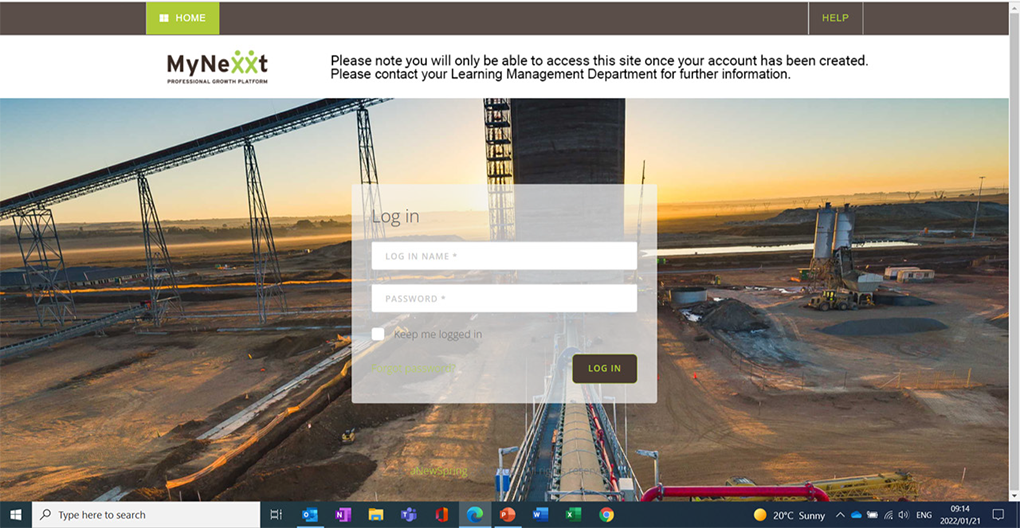
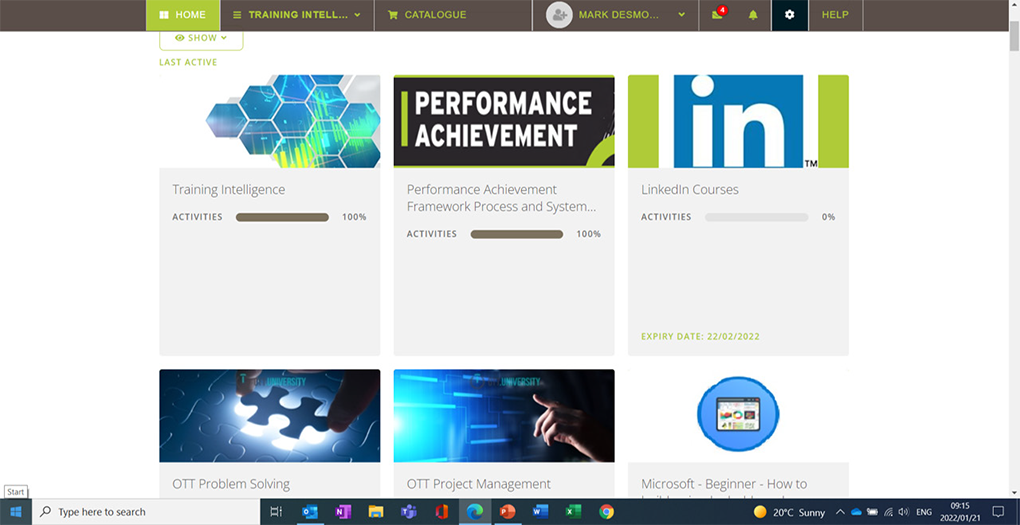
The MyNexxt platform was developed in 2019 and created an opportunity to increase online learning. More than 200 safety, health and environmental compliance courses are offered through MyNexxt. In 2021, 80 303 courses were completed by employees and contractors online. The platform also made it possible to provide blended and e-learning in new legislation introductions, Exxaro governance and risk themes as well as working remotely. Courses cover the Protection of Personal Information Act, 2013 (Act 4 of 2013) (POPIA), anti-bribery and corruption, cybersecurity, insider trading, implicit and unconscious bias, and using Office 365 functionalities.
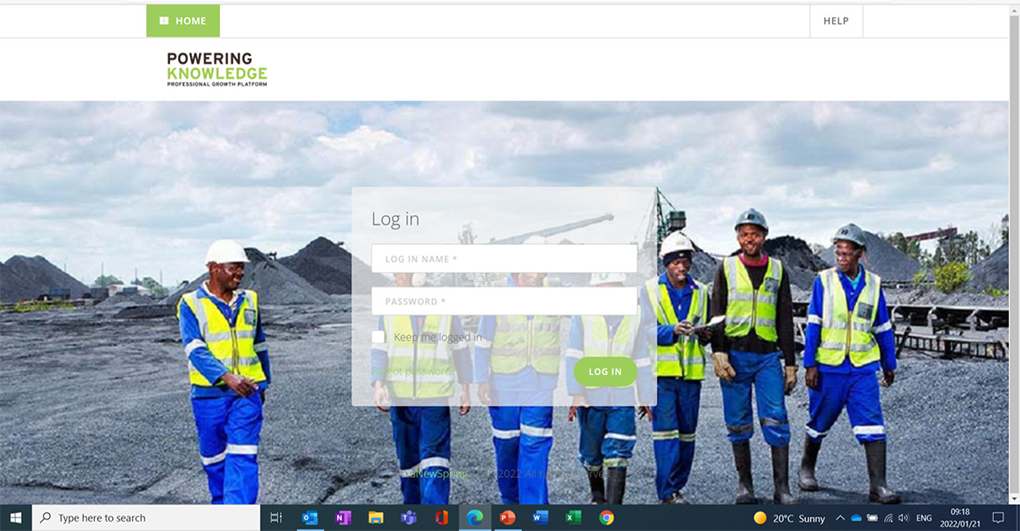
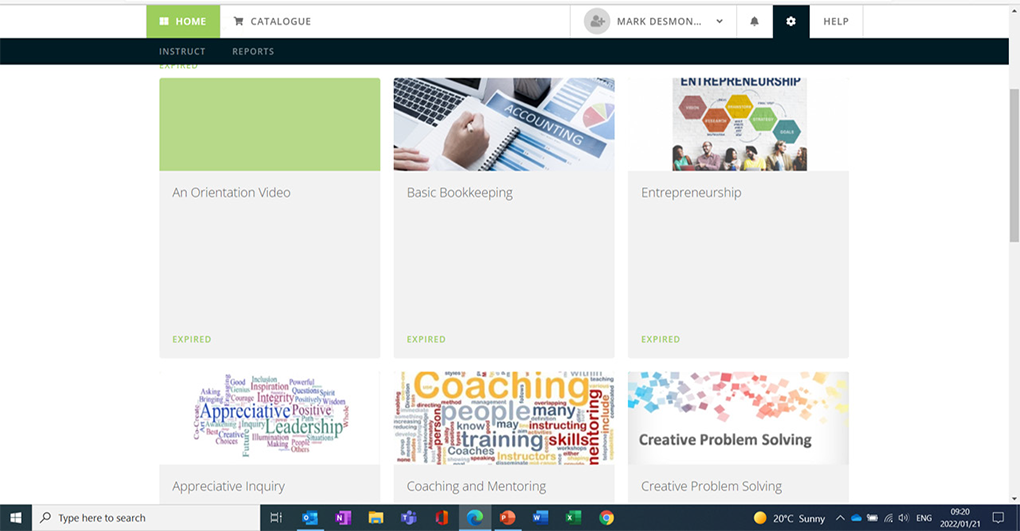
Like the employee MyNexxt platform, the Powering Knowledge platform is used for entrepreneurial, financial and project management skills development among community members who run SMMEs. Two pilot programmes were completed at Grootegeluk and Belfast as part of the community and social development initiative.
 Report Index
Report Index Integrated Report 2021
Integrated Report 2021
